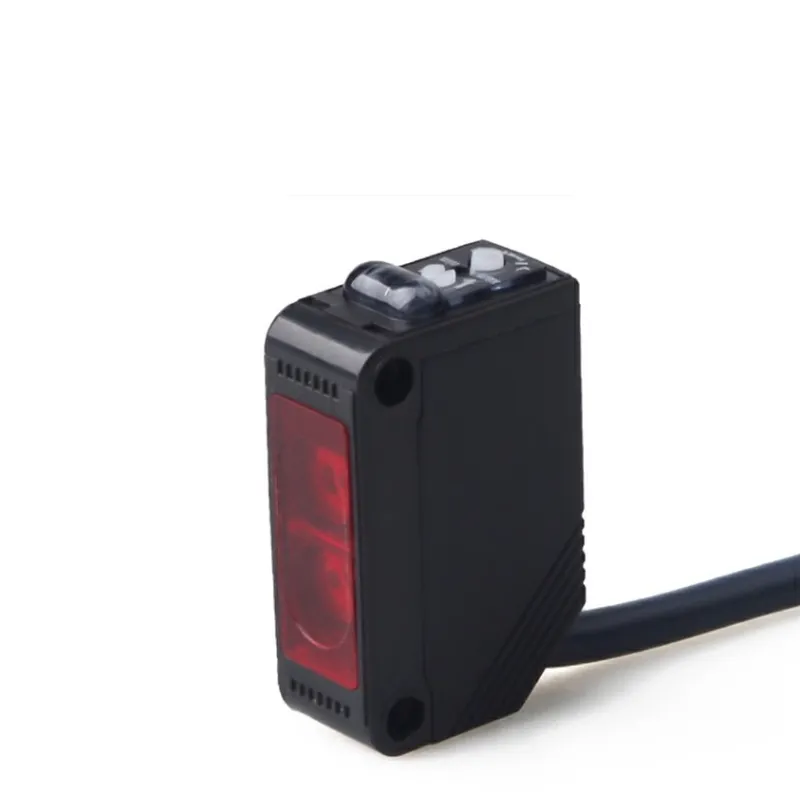Meccanismi Fondamentali dei Fotointerruttori
Sensori a Fascio Attraversante e Retroriflettenti
Esistono due tipi principali di interruttori fotoelettrici basati su sensori a sbarramento o sensori a riflessione. I sensori a sbarramento funzionano inviando un fascio di luce da un emettitore a un ricevitore. Quando qualcosa si muove nel percorso di quel fascio luminoso, il sensore lo rileva. Questo metodo sembra ideale quando è richiesta una misurazione ad alta precisione su lunghe distanze, con risultati affidabili. I sensori a riflessione, invece, riflettono la luce su una superficie riflettente e la riportano al sensore. Non è necessaria una linea di vista diretta per questi sensori, che sono adatti a spazi ristretti o luoghi con livelli di luminosità diversi.
Tecnologia di Rilevamento Diffuso
La tecnologia di rilevamento diffuso non richiede riflettori, il che semplifica il rilevamento. Le prestazioni di questa tecnologia sono garantite a distanze relativamente brevi e in ambienti esterni, ed è economicamente vantaggiosa. A differenza dei sensori a sbarramento e retroriflettenti, i sensori diffusi rilevano il bersaglio all'interno del cono di luce emesso, confermando le diverse proprietà dell'oggetto, come colore e materiale. Questa capacità è molto utile in ambienti industriali per scopi quali la selezione e l'ispezione, dove è fondamentale distinguere le diverse proprietà degli oggetti.
In conclusione, gli interruttori fotoelettrici, potenziati da queste tecnologie, offrono soluzioni di rilevamento affidabili, precise e versatili, ideali per le moderne esigenze di automazione.
Vantaggi operativi per l'efficienza industriale
Riduzione degli errori nel controllo qualità
Gli interruttori fotoelettrici trasformano il modo in cui le aziende controllano la qualità, riducendo drasticamente l'errore umano, fino all'80% una volta automatizzati. Una riduzione così straordinaria è realizzabile solo perché gli interruttori fotoelettrici sono in grado di controllare costantemente il fabbisogno di materiali. Automatizzano la fase di rilevamento, per garantire che un prodotto arrivi alla spedizione con livelli di qualità estremamente precisi. Questo processo automatizzato migliora la ripetibilità dei risultati e la fiducia dei consumatori nella trasparenza dei prodotti. Ciò consente alle aziende di mantenere standard elevati e una migliore qualità di consegna grazie alla rapida rilevazione di difetti o deviazioni.
Rilevamento ad Alta Velocità di Oggetti
Gli interruttori fotoelettrici ad alta velocità possono essere applicati a tutti i tipi di settori per migliorarne l'efficienza. Queste unità vantano tempi di rilevamento inferiori ai millisecondi, rendendoli indispensabili per qualsiasi rilevamento di impatto sulle linee di assemblaggio. La rapidità di risposta di questi interruttori è ideale per l'impiego in linee di produzione sempre più sottoposte a pressioni crescenti: le operazioni non saranno ostacolate dall'eliminazione di potenziali colli di bottiglia. Questa caratteristica ha aumentato la produttività e ridotto i costi operativi consentendo ai sistemi di funzionare ininterrottamente. Una buona produzione migliora le opportunità di produttività, riduce i costi e l'utilizzo delle risorse.
Versatilità dei Materiali e dell'Ambiente
Rilevamento di Sostanze Non Metalliche
È importante sottolineare che gli interruttori fotoelettrici sono sensori molto utili per il rilevamento di materiali, non solo metallici ma anche non metallici come dielettrici e materie plastiche, poiché la loro sensibilità può essere progettata in modo altamente ottimizzato. Ciò è particolarmente importante in applicazioni come l'imballaggio e lo stoccaggio, dove la flessibilità nel rilevamento dei materiali può guidare l'innovazione di processo. L'applicazione degli interruttori fotoelettrici per il rilevamento di materiali non metallici è più di un semplice sistema di rilevamento di metalli convenzionale. Il loro utilizzo in molti settori produttivi annuncia una nuova era tecnologica. La capacità di rilevare materiali come vetro, plastica e altri materiali trasparenti consente un'ampia gamma di applicazioni e consente ai produttori di rendere le loro linee più versatili ed efficienti. Questa adattabilità non solo migliora gli attuali processi di lavoro, ma sfrutta anche l'ispirazione per affrontare nuove problematiche di produzione.
Prestazioni in ambienti contaminati
Gli interruttori fotoelettrici continuano a funzionare perfettamente e in modo affidabile anche in ambienti sporchi, come nell'industria alimentare e delle bevande, dove la pulizia è un requisito assoluto. Il loro design robusto resiste alle condizioni più difficili, garantendone l'integrità ovunque la pulizia sia una necessità assoluta. Gli impianti che integrano gli interruttori fotoelettrici in processi potenzialmente contaminati riducono fino al 30% il rischio di contaminazione del prodotto, migliorando l'integrità del marchio e la sicurezza dei consumatori. Inoltre, resistente alle condizioni ambientali, il dispositivo continua a funzionare senza problemi anche in condizioni ambientali non ideali, per soddisfare gli elevati standard dei clienti in materia di produzione alimentare e farmaceutica.
Soluzioni Economiche per l'Efficienza Energetica
Affidabilità a Lungo Termine
Gli interruttori fotoelettrici rappresentano una spesa una tantum, sebbene un acquisto sostanziale, ma sono così convenienti da rientrare facilmente in un budget. Questi interruttori offrono notevoli risparmi energetici, riducendo significativamente i costi operativi ed eliminando le spese di manutenzione continua; questo notevole livello di durata li rende più che utilizzabili per tutta la loro precedente vita utile. Inoltre, gli studi dimostrano che le industrie potrebbero ottenere risparmi annuali di oltre il 20% sui costi energetici gestendo adeguatamente le tecnologie fotoelettriche. Questo vantaggio consente la riduzione dei costi e il mantenimento di elevati livelli di produzione attraverso sistemi applicativi per l'automazione di quest'ultima. Un'applicazione di interruttori fotoelettrici collaudata nel tempo promette di essere la ricetta per il successo aziendale, contribuendo al profitto, senza sacrificare la produttività.
Funzionamento LED a Basso Consumo Energetico
I sensori con tecnologia LED sono particolarmente efficienti dal punto di vista energetico e possono durare fino a 50.000 ore. Luci a LED: questi prodotti richiedono meno energia per alimentare il dispositivo, a parità di prestazioni. Non dovrai più preoccuparti di perdere energia rispetto ai lettori MP3 tradizionali. Supporto per la durata della batteria: questa serie di lettori ha una batteria a lunga durata; puoi anche risparmiare energia spegnendo lo schermo tramite il blocco dei pulsanti. La ricerca dimostra che la tecnologia dei sensori a LED può ridurre il consumo di energia fino al 90% rispetto alle lampade a incandescenza equivalenti, con un conseguente risparmio energetico a lungo termine. Questa è una soluzione lungimirante, che soddisfa non solo gli standard energetici internazionali, ma incoraggia anche la leadership ambientale in vari settori. L'uso della tecnologia LED supporta le aziende nell'efficienza operativa e nelle operazioni ecosostenibili, oggi molto richieste per un processo di produzione ecosostenibile.

Miglioramenti della sicurezza nell'automazione industriale
Tendini di Sicurezza Integrati
Le barriere fotoelettriche di sicurezza con sensori fotoelettrici trovano un'importante applicazione nella protezione del personale addetto ai lavori in un sito industriale. Grazie al rilevamento completo delle persone nelle aree pericolose, questi sistemi possono prevenire incidenti causati da macchinari in movimento. Le caratteristiche principali sono: il rilevamento tramite sensore fotoelettrico, che garantisce un monitoraggio preciso e affidabile, è in grado di individuare effrazioni o intrusioni nell'area protetta. Ciò consente l'arresto immediato delle apparecchiature per evitare possibili lesioni ai lavoratori. In termini numerici, le barriere fotoelettriche di sicurezza possono ridurre gli incidenti nei siti industriali fino al 40%, con un notevole risparmio sugli standard di sicurezza per i lavoratori.
Sistemi di Prevenzione degli Incidenti
Grazie al supporto degli interruttori fotoelettrici, i sistemi di prevenzione degli incidenti sono componenti essenziali delle attuali disposizioni di sicurezza industriale. Questi impianti sono predisposti per rispondere rapidamente alle emergenze e ridurre al minimo gli infortuni sul lavoro. Ogni volta che viene identificata una minaccia, questi interruttori fotoelettrici possono arrestare i macchinari quasi immediatamente, riducendo il rischio di incidenti. Gli esperti sottolineano che i sistemi automatizzati ad attivazione vocale sono conformi alle norme di sicurezza e queste risposte stanno promuovendo ulteriori normative, creando a loro volta un ambiente di lavoro più sicuro. La risposta rapida e precisa degli interruttori fotoelettrici è vantaggiosa per migliorare la sicurezza e rappresenta un motivo più interessante per il loro utilizzo in ambito industriale.
Applicazioni Specifiche per l'Industria che Promuovono l'Efficienza
Norme igieniche per l'elaborazione dei prodotti alimentari
Nel settore della trasformazione alimentare, la pulizia è fondamentale per la tutela della salute e la qualità dei beni di consumo. Gli interruttori fotoelettrici svolgono un ruolo cruciale nel rispetto di questi ambiziosi requisiti igienici. Sono dispositivi senza contatto, il che li rende meno soggetti a contaminazione nei processi produttivi poiché rilevano la presenza di sostanze senza contatto. Questa capacità si sposa bene con l'enfasi che gli enti regolatori attribuiscono alla prevenzione della contaminazione degli ambienti di trasformazione alimentare. Con l'utilizzo di interruttori fotoelettrici, le fabbriche possono migliorare gli standard igienici, garantendo la sicurezza dei prodotti per i consumatori e la conformità alle rigorose normative in materia di salute e sicurezza stabilite dagli enti sanitari.
Ottimizzazione della Linea di Produzione Automobilistica
Le linee di produzione dell'industria automobilistica sono, per loro natura, e non da ultimo nella produzione di automobili, dove efficienza e precisione contano davvero, e in questo campo gli interruttori fotoelettrici hanno dato un contributo significativo all'implementazione di una produzione ottimizzata. Riducono i tempi di assemblaggio poiché consentono operazioni ad alta velocità e minori tempi di fermo. Secondo la ricerca, le case automobilistiche possono ottenere un aumento del 25% dell'efficienza produttiva utilizzando la tecnologia di commutazione fotoelettrica, e questo notevole aumento si traduce in un aumento della produzione e in una riduzione dei costi di produzione. Ciò renderebbe non solo la produzione più veloce, ma anche una migliore qualità del veicolo costruito, poiché i componenti vengono allineati e avvitati correttamente.
Domande Frequenti
Quali sono i meccanismi principali degli interruttori fotoelettrici?
Fondamentalmente, la commutazione fotoelettrica si basa su segnali, sensori a riflessione e sensori diffusi. I sensori a sbarramento funzionano inviando luce da un emettitore a un ricevitore; il fascio luminoso viene interrotto, attivando così il sensore. I sensori si basano su superfici riflesse anziché su un fascio luminoso trasparente. I sensori trasmissivi rilevano gli oggetti nel cono di luce emesso.
Come i fotointerruttori riducono gli errori nel controllo qualità?
I fotointerruttori minimizzano gli errori umani e automatizzano il processo di rilevazione nel controllo qualità. Essi garantiscono che i prodotti rispettino standard precisi prima di raggiungere la fase di spedizione, migliorando la affidabilità statistica e la fiducia del consumatore.
In quali settori vengono comunemente utilizzati i fotointerruttori?
Gli interruttori fotoelettrici vengono comunemente utilizzati nei settori come la trasformazione alimentare, la produzione automobilistica, l'imballaggio e il magazzino per compiti come il mantenimento dell'igiene, l'ottimizzazione della linea di produzione, la rilevazione ad alta velocità degli oggetti e la rilevazione di sostanze non metalliche.
Perché gli interruttori fotoelettrici a LED sono considerati efficienti dal punto di vista energetico?
Gli interruttori fotoelettrici a LED consumano meno energia rispetto alle alternative tradizionali. La loro operazione efficiente in termini di energia si allinea con gli standard energetici globali e con le iniziative di sostenibilità, rendendoli una scelta preferita per pratiche ecologiche.
Indice
- Meccanismi Fondamentali dei Fotointerruttori
- Vantaggi operativi per l'efficienza industriale
- Versatilità dei Materiali e dell'Ambiente
- Soluzioni Economiche per l'Efficienza Energetica
- Miglioramenti della sicurezza nell'automazione industriale
- Applicazioni Specifiche per l'Industria che Promuovono l'Efficienza
- Domande Frequenti

